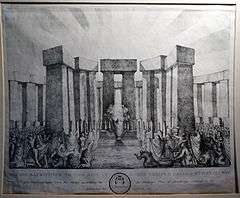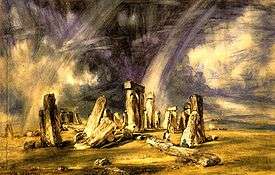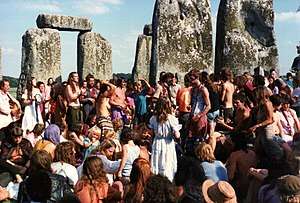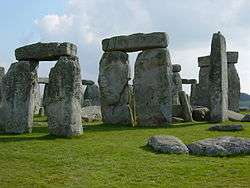Cultural depictions of Stonehenge
The Prehistoric landmark of Stonehenge is distinctive and famous enough to have become frequently referenced in popular culture. The landmark has become a symbol of British culture and history, owing to its distinctiveness and its long history of being portrayed in art, literature and advertising campaigns, as well as modern media formats, such as television, film and computer games. This is in part because the arrangement of standing stones topped with lintels is unique, not just in the British Isles, but in the world.

Art and mythology

The interest in 'ancient' Britain can be traced back to the sixteenth and seventeenth centuries, following the pioneering work of the likes of William Camden, John Aubrey, and John Evelyn. The rediscovery of Britain's past was also tied up in the nation's emerging sense of importance as an international power. Antiquarians and archaeologists, notably William Stukeley, were conducting excavations of megalithic sites, including Stonehenge and the nearby Avebury. Their findings caused considerable debate on the history and meaning of such sites, and the earliest depictions reflected a search for a mystical explanation.
Earlier explanations, including the view proposed by Inigo Jones in 1630, that Stonehenge was built by the Romans such was its sophistication and beauty, were disproved in the late seventeenth century. It was proven that Stonehenge was the work of indigenous neolithic peoples. From this period onwards artists made images of barrows, standing stones, and excavated objects which increasingly drew on highly imaginative ideas about the prehistoric people who created them. These helped to create the image of Britain that a broadening audience was becoming aware of through illustrated books, maps, and prints. Poets and other writers deepened the impact of this visual material by imagining ancient pasts and mythologising the distant roots of the growing British Empire. Debates about British ancestry and national identity saw a growing conviction that the British were an ancient people, and that the newly named 'United Kingdom', might find greater harmony through searching for a common past. For the English, this past was to be found in the West, starting around Stonehenge and stretching into the ancient Celtic regions of Wales and Cornwall.


During the early nineteenth century it was artists such as John Constable and J.M.W. Turner who helped to make the megalithic sites a part of the popular imagination and understanding of Britain's past. The philosopher Edmund Burke proposed the idea of the 'sublime' sense as being evoked by 'feelings of danger and terror, obscurity and power, in art as well as life'. This was already a feature of artistic and literary works of the period, and provided the theoretical basis for a growing appreciation of desolate landscapes and ancient ruins. For these reasons Stonehenge became of particular interest for artists. Burke himself wrote
"Stonehenge, neither for disposition nor ornament, has anything admirable; but those huge rude masses of stone, set end on end, and piled high on each other, turn the mind on the immense force necessary for such a work."
The very nature of the barren Wiltshire landscape, and Salisbury Plain became particularly notable for the apparently miraculous powers that created Stonehenge. William Wordsworth wrote
Pile of Stone-henge! So proud to hint yet keep
Thy secrets, thou lov'st to stand and hear
The plain resounding to the whirlwind's sweep
Inmate of lonesome Nature's endless year.
Turner and Constables' paintings were arranged for a romantic effect and deviated from the actual state of the stones. Turner particularly added stones that were not there in reality, and those that were, were incorrect in their dimensions. Throughout the nineteenth century, a new motive emerged in the depictions of Stonehenge, that of an anti-pagan approach, with paintings by the likes of William Overend Geller, with his painting The Druid's Sacrifice in 1832. In the novel "Tess of the d'Urbervilles" by Thomas Hardy, the main character, Tess, is captured by the police at Stonehenge, the 'heathen' nature of the setting being used to highlight the character's temperament.
The image of Stonehenge became adapted in the twentieth century by those wishing to advertise using a monument viewed as a symbol of Britain. The Royal Navy exploited this sense of identification by naming an S-class destroyer and one of their S-class submarines HMS Stonehenge. The Shell Oil Company commissioned the artist Edward McKnight Kauffer to paint a series of posters during the interwar period, to be used to encourage tourism by car owners. Stonehenge was one of those depicted.
In contemporary popular culture

By now a powerful and instantly recognisable symbol, the monument has been featured in a wide number of ways.
The monument continues to be featured in film, television, and radio, either to question the origin or history of Stonehenge, or to play upon its position as an instantly recognisable structure and symbol of Britain. In books by Kurt Vonnegut and S. M. Stirling, amongst others, alternative theories are suggested and explored as part of the larger plot. The monument has also become popular in computer games, wherein alternative uses are often posited for Stonehenge, or its iconic nature is explored.
Music
For example, The Beatles are seen performing on Salisbury Plain with Stonehenge visible in the background in their film Help! (1965). The site has also been used for concerts, starting with the Stonehenge Free Festival in 1972. Hawkwind regularly performed at the festival, and their 1976 "Atomhenge" tour featured a stage set that replicated the monument.[1]
Black Sabbath's album Born Again (1983) features an instrumental called "Stonehenge", which led manager Don Arden to suggest a stage set based upon the stones. The plans were mistakenly labelled in metres not feet, so that when the stage set was erected it was three times the desired size - dwarfing the band. The set was only used once, and the incident was famously parodied in the mockumentary film This is Spinal Tap (1984), which features the titular fictional rock band performing a song named "Stonehenge" on stage. In one of the many embarrassing events on their comeback tour, confusion about abbreviating inches and feet results in a Stonehenge replica so small that it was in danger of being trod upon by the Little People hired to dance around it.[1]
Ylvis' song "Stonehenge" is a paean to the monument. The lyrics question the motivation and methods of the builders, asking, "What's the purpose of Stonehenge? A giant granite birthday cake or a prison far too easy to escape?"[2]
Italian luthier Alfredo Bugari designed a guitar which he called "Stonehenge".
In his song "Elvis Is Everywhere", Mojo Nixon asks, "Who built Stonehenge?", and the chorus emphatically responds, "Elvis!"
Literature
Stonehenge features prominently in Peter Ackroyd's novel Hawksmoor (1985).
In The Secrets of the Immortal Nicholas Flamel, Stonehenge features as sort of portal hub, with the spaces between the stones becoming doorways that open to different locations around the world.
Television
Stonehenge plays a big role in the Doctor Who episodes "The Pandorica Opens" and "The Big Bang".
In the BBC comedy show Dave Allen at Large, a sketch shows Dave Allen at the stones. Bored with the tourist guide's lecturing, he rests, lights a cigarette, and leaning against one of the rocks sends them toppling over.[3]
In an episode of SpongeBob SquarePants, called "Spongehenge", SpongeBob creates a large monument of stone sponges similar to Stonehenge in order to distract jellyfish.
In the premiere of The Amazing Race 17, Stongehenge was the first location the competing teams had to travel to after arriving in England in order to find a clue.[4]
There is an episode of Uchu Sentai Kyuranger wherein the great heroes must face a Stonehenge-themed Monster.
In Legends of Tomorrow, Stonehenge is used to open a portal to hell.[5]
Movies
The final scenes of Roman Polanski's film Tess (1979), based on the novel Tess of the d'Urbervilles by Thomas Hardy, takes place at Stonehenge. The title character is apprehended by police at dawn.[6]
The villain of the science fiction-horror film Halloween III: Season of the Witch (1982) steals Stonehenge and puts pieces of it into masks which have the ability to turn people's heads into bugs and snakes.
In the cult horror movie Troll 2, a piece of Stonehenge gave the vegetarian antagonists nefarious power until the young hero eats a "double-decker" baloney sandwich to destroy it.
In the cult horror classic Curse of the Demon (1957), the lead character, played by Dana Andrews, transcribes runes along Stonehenge, which is also mentioned in The Rocky Horror Picture Show song "Science-Fiction", with the lyrics stating: "Dana Andrews said 'Prunes!' gave him the runes."
In a scene from the comedy film National Lampoon's European Vacation (1985), Clark Griswold backs a hired Austin Maxi into one of the stones, creating a domino effect on all the upright stones.
In the animated film Ice Age (2002), the main characters pass by Stonehenge during their journey. Manny, a woolly mammoth, dismisses Stonehenge as mere "modern architecture", commenting, "It'll never last".[7]
In the Malaysian-made fantasy film Vikingdom, Stonehenge is the center point where three artifacts (the horn of Helheim, Thor's hammer, and the necklace of Mary Magdalene) must be united during a "blood eclipse" to bring about Ragnarok, and the film's climax takes place there. Unlike the real Stonehenge, this one is located at the edge of a cliff.
In Transformers: The Last Knight, Stonehenge was the center point of Unicron's six horns during the Pangaea era, when the horns were in a circular formation.
Video games
One of the venues in the rhythm game Guitar Hero II (2006) takes place at Stonehenge, echoing the above Spinal Tap example.
The Ace Combat series of video games features a collection of railguns referred to as Stonehenge, which bear a resemblance to the real-life monument due to their circular arrangement.
Stonehenge Base, in the game EarthBound, is a direct reference to Stonehenge.
| Wikimedia Commons has media related to Stonehenge in art. |
In Pokémon Sword and Shield, the Pokémon Stonjourner is based on Stonehenge.
The puzzle game The Bradwell Conspiracy, developed by Bossa Studios, is set in a 2026 depiction of Stonehenge.
The turn-based strategy series Civilization features Stonehenge as a wonder which a player can build in Civilization IV, Civilization V and Civilization VI.
Comics
- In A Midwinter Morning’s Dream (Corto Maltese story by Hugo Pratt, first published in 1972 and present in the volume Celtic Tales), Stonehenge is the meeting place of characters from Celtic mythology.
References
- Weston, Donna; Bennett, Andy (2014). Pop Pagans: Paganism and Popular Music. p. 31. ISBN 9781317546665.
- Video on YouTube
- BBC
- ""Amazing Race:" 11 Teams Storm Castle Battlements". CBS News. 27 September 2011. Retrieved 8 January 2020.
- Rovenstine, Dalene (6 May 2019). "Legends of Tomorrow recap: Gary got his nipple — and his groove — back". Entertainment Weekly. Retrieved 7 May 2019.
- Tess (1979 film)
- IMDB https://www.imdb.com/title/tt0268380/quotes. Retrieved 11 January 2018. Missing or empty
|title=(help)
- David Dimbleby (2005), A Picture of Britain, Tate Publishing, ISBN 1-85437-566-0
- James McClintock (2006), The Stonehenge Companion, English Heritage ISBN 1-905624-08-5
- Evan Hadingham (1976), Circles and Standing Stones, William Heinemann Ltd.
- Julian Richards (2004), Stonehenge: A History in Photographs, English Heritage ISBN 1-85074-895-0
- Aubrey Burl (1979), Prehistoric Avebury, Yale University Press ISBN 0-300-02368-5

